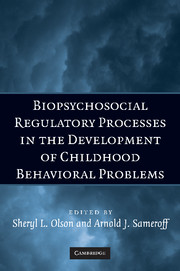Book contents
- Frontmatter
- Contents
- Preface
- Contributors
- 1 Conceptual Issues in Studying the Development of Self-Regulation
- 2 How Gene-Environment Interactions Can Influence the Development of Emotion Regulation in Rhesus Monkeys
- 3 Context Matters: Exploring Definitions of a Poorly Modulated Stress Response
- 4 An Integrative Approach to the Neurophysiology of Emotion Regulation: The Case of Social Withdrawal
- 5 Regulatory Competence and Early Disruptive Behavior Problems: The Role of Physiological Regulation
- 6 Behavior Regulation as a Product of Temperament and Environment
- 7 Self-Regulatory Processes in the Development of Disruptive Behavior Problems: The Preschool-to-School Transition
- 8 Emotional Dysregulation and the Development of Serious Misconduct
- 9 Regulatory Processes in Children's Coping with Exposure to Marital Conflict
- 10 Family Subsystems and Children's Self-Regulation
- 11 Culture and the Development of Regulatory Competence: Chinese–U.S. Comparisons
- 12 Self-Regulation and the Development of Behavioral and Emotional Problems: Toward an Integrative Conceptual and Translational Research Agenda
- Index
- References
2 - How Gene-Environment Interactions Can Influence the Development of Emotion Regulation in Rhesus Monkeys
Published online by Cambridge University Press: 02 July 2009
- Frontmatter
- Contents
- Preface
- Contributors
- 1 Conceptual Issues in Studying the Development of Self-Regulation
- 2 How Gene-Environment Interactions Can Influence the Development of Emotion Regulation in Rhesus Monkeys
- 3 Context Matters: Exploring Definitions of a Poorly Modulated Stress Response
- 4 An Integrative Approach to the Neurophysiology of Emotion Regulation: The Case of Social Withdrawal
- 5 Regulatory Competence and Early Disruptive Behavior Problems: The Role of Physiological Regulation
- 6 Behavior Regulation as a Product of Temperament and Environment
- 7 Self-Regulatory Processes in the Development of Disruptive Behavior Problems: The Preschool-to-School Transition
- 8 Emotional Dysregulation and the Development of Serious Misconduct
- 9 Regulatory Processes in Children's Coping with Exposure to Marital Conflict
- 10 Family Subsystems and Children's Self-Regulation
- 11 Culture and the Development of Regulatory Competence: Chinese–U.S. Comparisons
- 12 Self-Regulation and the Development of Behavioral and Emotional Problems: Toward an Integrative Conceptual and Translational Research Agenda
- Index
- References
Summary
INTRODUCTION
Humans do not have a monopoly on emotionality. More than a century ago, Charles Darwin (1872) provided compelling arguments that some animals, especially mammals, are capable of expressing human-like emotions. Today, an increasing body of research convincingly demonstrates that most nonhuman primates possess the same basic neural circuitry and exhibit the same general patterns of neurochemical change that have been implicated in human emotional expression (cf. Panksepp, 1998). Monkeys and apes routinely display characteristic patterns of emotional expression that seem strikingly similar to, if not homologous with, those routinely exhibited by infants and young children in virtually every human culture studied to date. To be sure, some complex emotions such as shame are most likely exclusively human, but they apparently require cognitive capabilities well beyond those of human infants and nonhuman primates of any age (cf. Lewis, 1992). The more basic emotions, such as fear, interest, surprise, and rage, are clearly expressed soon after birth by human and nonhuman primate infants alike, and their expression is usually obvious to all around; that is, they serve as highly visible and salient social signals (cf. Suomi, 1997b).
Ethologists have long argued that these basic emotions, having been largely conserved over mammalian evolutionary history, serve important adaptive functions (i.e., they are thought to enhance the immediate survival and long-term fitness of the individuals expressing them).
- Type
- Chapter
- Information
- Biopsychosocial Regulatory Processes in the Development of Childhood Behavioral Problems , pp. 19 - 37Publisher: Cambridge University PressPrint publication year: 2009
References
- 2
- Cited by



